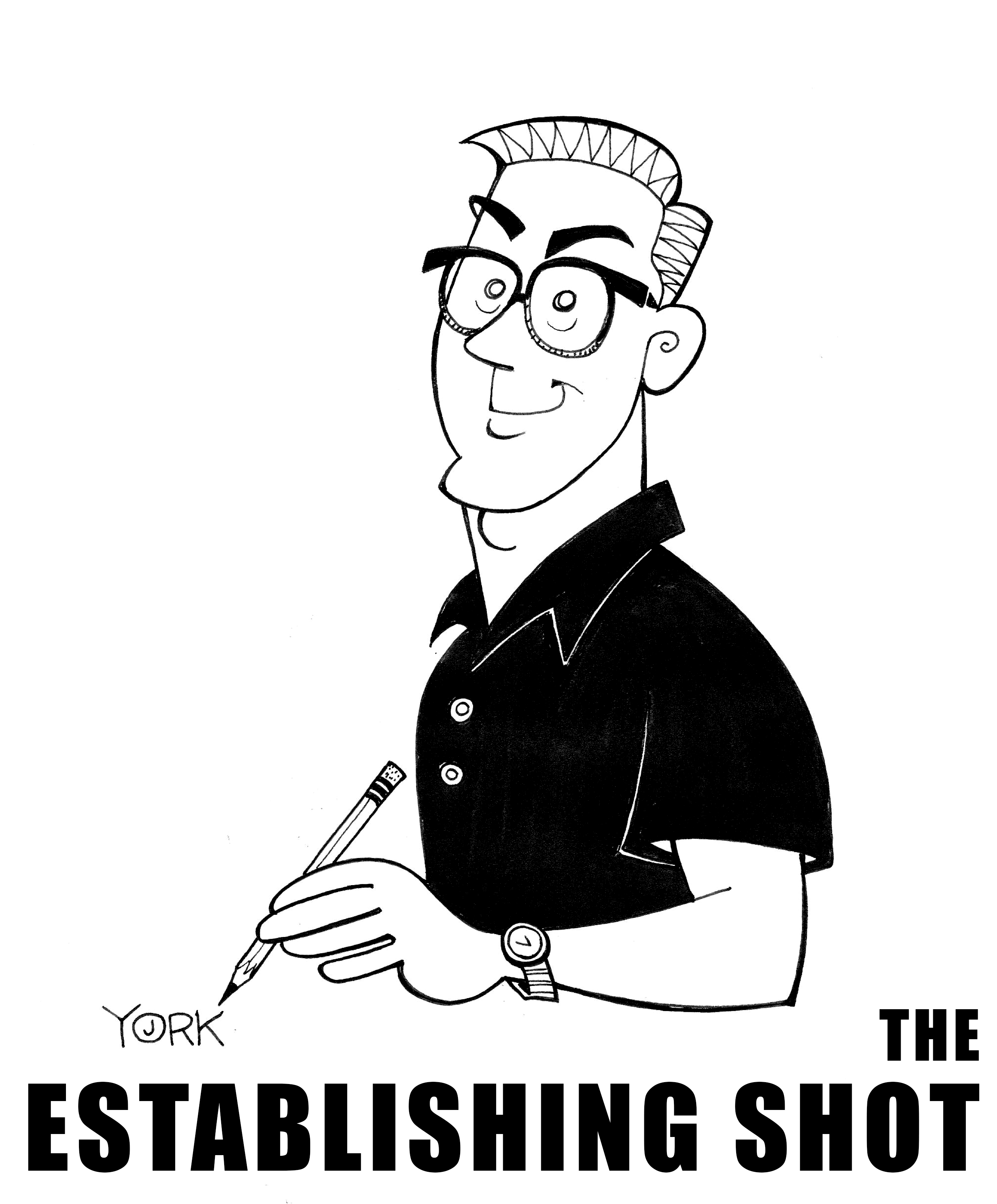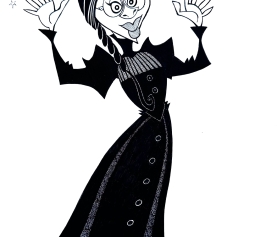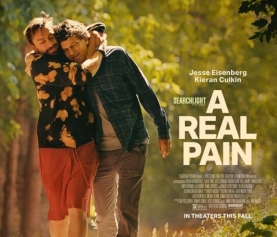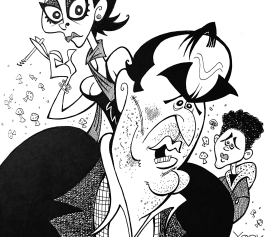 |
| Original caricature by Jeff York of Rooney Mara as MARY MAGDALENE. (copyright 2019) |
It’s Easter week, and appropriately, a new movie about Jesus hits theaters this weekend. He’s not the main character here, as this one is entitled MARY MAGDALENE. Indeed, this tale of Christ is told through the experience of the second most famous Mary in all of Christianity. And if you are expecting to see her presented as a prostitute, you’re going to be very surprised. The material here is revisionist, grittier, blunter, and yet still incredibly moving and poignant.
For centuries, Pope Gregory’s wrongful interpretation of Mary Magdalene in 591 A.D. has colored her story. The besmirching of her character was a vicious idea to hoist the patriarchal agenda, and this film will have none of it. Thankfully, the Vatican formally identified Mary as Apostle of the Apostles in 2016, and this film treats her that way from the get-go. In fact, the character is introduced as an invaluable member of her community, one who has similar qualities of the Messiah already inside her.
The film starts with a young woman about to give birth, and the pain is pushing her into a panicked frenzy. Mary (Rooney Mara) is called, and she’s not only able to hold her down with her physical strength, but she connects with the mother-to-be, lying next to her on the ground and soothing her with compassionate words. This scene is echoed shortly afterward, only with Mary in the vulnerable position. She rejects her father’s pick for a suitor and is nearly drowned by her brothers to force the rebellious ‘demon’ out of her. As she shivers uncontrollably on the floor, wholly discombobulated by her near murder, a healer is brought in to provide comfort. That man is Jesus (Joaquin Phoenix).
As he connects with her, similar to how Mary calmed the expectant mother, the healer realizes that she is strong enough to recover on her own. He leaves, thoroughly impressed by Mary’s gumption and strength, recognizing a kindred and brave soul in his midst. Soon, she will follow him, more and more impressed by his words and actions, and vice versa.
Soon, Mary leaves all she has known to follow Jesus. She witnesses him, talking casually to a crowd about how thinking outside yourself and helping others, particularly the suffering, is a righteous path to God. As Jesus inspires her, let alone all of them with his ideas of inclusion, he discovers a blind woman. She is smiling as his stories of inclusion make her feel welcome, not shunned. Then, he calmly touches her eyelids, and in a matter of seconds, she is healed and can see again. It’s an incredibly delicate scene, played evenly, realistically, with no underscore, and it’s incredibly moving.
Such acts take a lot out of Jesus, however, and he almost faints afterward from the exhaustion. Mary catches him and helps ease his weary body to the ground. The film will continually show the partnership of Mary with Jesus like that throughout the story. He will inspire her, and she will respond in kind. In fact, the shrewd script by Helen Edmundson and Philippa Goslett suggests that all of Jesus’ disciples were less groupies and more like a rock band, relying on each other to keep the harmony in their messages.
Yet, even with the male disciples being shown as enlightened beings, they still lean towards patriarchal thinking and continually question Mary’s standing. She frequently has to prove herself, even though she never expresses doubt in the cause whereas Peter (Chiwetel Ejiofor) is forever uncertain. Mary finally wins him over when they happen upon a small abandoned village that’s been ransacked by the Roman guard. Only the ill and crippled remain, left behind as the able scattered. Peter argues that these castaways are lost causes, but Mary stubbornly stays with them to provide aid and comfort. Her plucky caretaking inspires Peter, and she helps him walk the walk, not just talk the talk.
I couldn’t help but be reminded of the classic scene in BEN-HUR where Judah storms into the leper colony to save his mother and sister. That is the kind of bravery and righteousness that Mary exhibits in that scene and throughout the film. Few play stalwart and righteous as well as Mara, and she brings some of that Lisbeth Salander stubbornness of hers to this part too.
Director Garth Davis, who scored such an intensely emotional connection with audiences two years ago with LION, wisely underplays the pathos and drama here. Instead, what he focuses on is giving the material both a realism and a modernity that such adaptations of scripture rarely have shown. Jesus is not treated like some ethereal saint, but rather, as a caring teacher. It’s almost as if he’s an engaging prof pulling his flock into discussions of life and purpose. Phoenix looks like a ruffian, more vagrant or nomad in the desert than a prince of peace, but it works very well. This is a working, striving and driving Christ, one as no-frills and unadorned as all the other honesty and grit Davis pours into every scene.
The film takes a very modern slant on its look and its verbiage as well. While no one speaks with the Brooklyn accent that Harvey Keitel kept while playing Judas in Martin Scorsese’s THE LAST TEMPTATION OF CHRIST in 1988, the words here ring with a contemporary flavor. At one point, a woman in the crowd balks at Mary who’s speaking on behalf of Jesus. She criticizes her, complaining, “We are women. Our lives are not our own.” Mary doesn’t defend herself in this instance, Jesus does. He replies to the woman, “Your spirit is your own. And you alone answer for that.”
Even if you are a non-believer or someone of a different faith, it’s hard not to be inspired by such language. The film could almost serve as a sly rebuke of the great divide everywhere today, or at the very least, the asinine mansplaining that the patriarchy still engages in. This Christ even condemns the bitterness driving the gap, asking how those live with themselves when they’re filled with such hate. “Does your hate lessen as the days go by? Or does it instead seep into your days, your nights, until it consumes everything you once were.” Such words should give all of us pause. What are we doing to make the world a better place? Are we out there making a difference, or just sitting at home and bitching on Twitter?
Some may quibble with Phoenix and Mara in the lead, rather than actors of color. If the film were wholly revisionist, such roles would be cast considerably different, i.e., with Middle Eastern actors. Still, both acclaimed actors give terrific performances here, never overplaying their iconic characters. It’s a film uninterested in showiness, as Davis doesn’t exploit the crucifixion or the resurrection. (They take up very little screentime in all actuality.) Instead, the director uses these famous scenes mostly to showcase Mary’s steadfastness to the cause. She was there for it all, risking her life with every appearance. After all, she was the Apostle of the Apostles.
MARY MAGDALENE is both a feminist and humanist approach to the most famous story of all time, albeit one bringing more honesty and integrity to the telling. Friends, Romans, countrymen – they all underestimated Mary and fought here at every turn. She never shirked, never prostituted the cause or herself, and always kept positive. The film is showing us the brave path she took with a quiet and deliberate manner similar to her. How fitting. And how inspiring.







